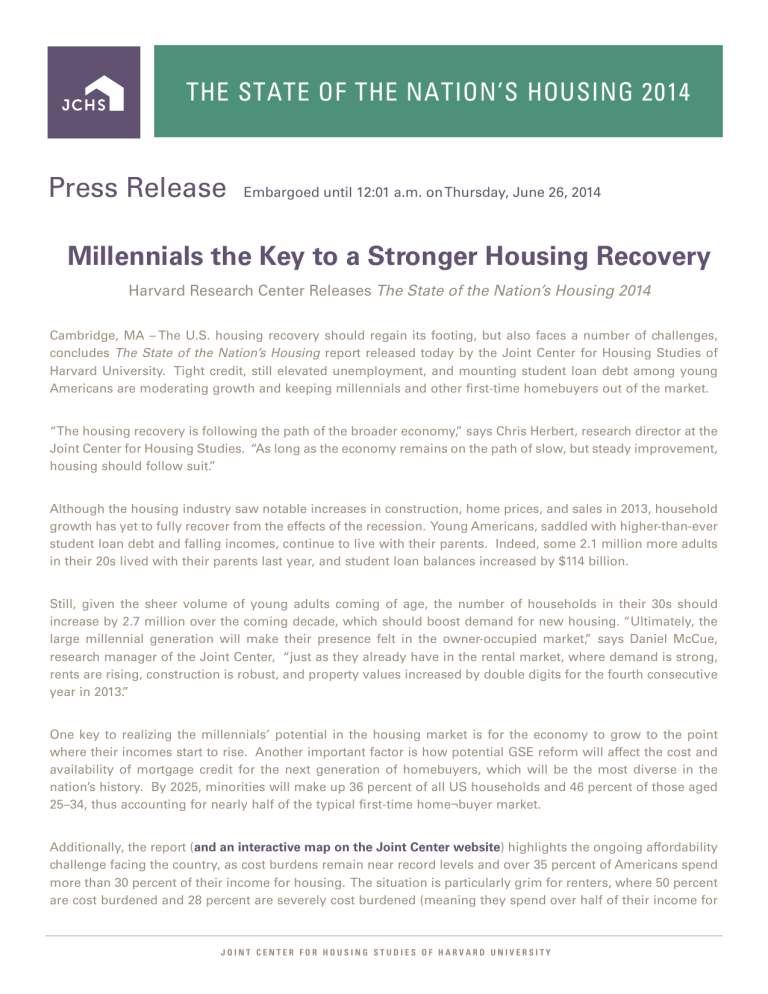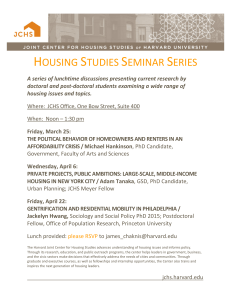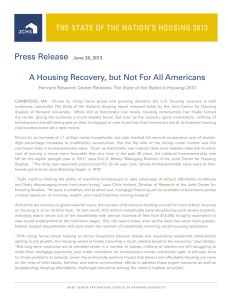Press Release Millennials the Key to a Stronger Housing Recovery

The sTaTe of The naTion’s housing 2014
Press Release
Embargoed until 12:01 a.m. on Thursday, June 26, 2014
Millennials the Key to a Stronger Housing Recovery
Harvard Research Center Releases The State of the Nation’s Housing 2014
Cambridge, MA – The U.S. housing recovery should regain its footing, but also faces a number of challenges, concludes The State of the Nation’s Housing report released today by the Joint Center for Housing Studies of
Harvard University. Tight credit, still elevated unemployment, and mounting student loan debt among young
Americans are moderating growth and keeping millennials and other first-time homebuyers out of the market.
“The housing recovery is following the path of the broader economy,” says Chris Herbert, research director at the
Joint Center for Housing Studies. “As long as the economy remains on the path of slow, but steady improvement, housing should follow suit.”
Although the housing industry saw notable increases in construction, home prices, and sales in 2013, household growth has yet to fully recover from the effects of the recession. Young Americans, saddled with higher-than-ever student loan debt and falling incomes, continue to live with their parents. Indeed, some 2.1 million more adults in their 20s lived with their parents last year, and student loan balances increased by $114 billion.
Still, given the sheer volume of young adults coming of age, the number of households in their 30s should increase by 2.7 million over the coming decade, which should boost demand for new housing. “Ultimately, the large millennial generation will make their presence felt in the owner-occupied market,” says Daniel McCue, research manager of the Joint Center, “just as they already have in the rental market, where demand is strong, rents are rising, construction is robust, and property values increased by double digits for the fourth consecutive year in 2013.”
One key to realizing the millennials’ potential in the housing market is for the economy to grow to the point where their incomes start to rise. Another important factor is how potential GSE reform will affect the cost and availability of mortgage credit for the next generation of homebuyers, which will be the most diverse in the nation’s history. By 2025, minorities will make up 36 percent of all US households and 46 percent of those aged
25–34, thus accounting for nearly half of the typical first-time home¬buyer market.
Additionally, the report ( and an interactive map on the Joint Center website ) highlights the ongoing affordability challenge facing the country, as cost burdens remain near record levels and over 35 percent of Americans spend more than 30 percent of their income for housing. The situation is particularly grim for renters, where 50 percent are cost burdened and 28 percent are severely cost burdened (meaning they spend over half of their income for
J o i n t C e n t e r f o r H o u s i n g s t u d i e s o f H a r v a r d u n i v e r s i t y
t H e s t a t e o f t H e n a t i o n ’ s H o u s i n g 2 0 1 4 housing). “When available, federal rental subsidies make a significant difference in the quality of life for those struggling the most,” says Herbert. “Between 2007 and 2011, the number of Americans eligible for assistance rose by 3.3 million, while the number of assisted housing units was essentially unchanged. Sequestration forced further cuts in housing assistance, which have yet to be reversed.”
The State of the Nation’s Housing 2014 will be released by live webcast on Thursday, June 26 at Noon (Eastern) at www.jchs.harvard.edu.
Tweet your questions using the hashtag #harvardhousingreport
Download a PDF of The State of the Nation’s Housing 2014 and full media kit at: www.jchs.harvard.edu/state-nations-housing-2014-embargoed for More inforMation, ContaCt
Kerry Donahue, (617) 495-7640, kerry_donahue@harvard.edu
The State of the Nation’s Housing , released annually by the Joint Center for Housing Studies, provides a periodic assessment of the nation’s housing outlook and summarizes important trends in the economics and demographics of housing. The report continues to earn national recognition as an authoritative source of information regularly utilized by housing researchers, industry analysts, policy makers, and the business community.
Principal funding for this report was provided by the Ford Foundation and the Policy Advisory Board of the Joint Center for Housing Studies. Additional support was provided by the Federal Home Loan Banks, the Housing Assistance Council, the National Association of Home Builders, the National Association of Housing and Redevelopment Officials, the National
Association of Local Housing Finance Agencies, the National Association of Realtors®, the National Council of State Housing
Agencies, the National Housing Conference, the National Housing Endowment, the National Low Income Housing Coalition, the National Multifamily Housing Council, and the Research Institute for Housing America.
The Harvard Joint Center for Housing Studies advances understanding of housing issues and informs policy. Through its research, education, and public outreach programs, the center helps leaders in government, business, and the civic sectors make decisions that effectively address the needs of cities and communities. Through graduate and executive courses, as well as fellowships and internship opportunities, the Joint Center also trains and inspires the next generation of housing leaders. www.jchs.harvard.edu
J o i n t C e n t e r f o r H o u s i n g s t u d i e s o f H a r v a r d u n i v e r s i t y




